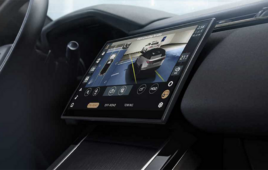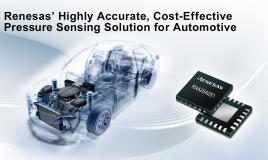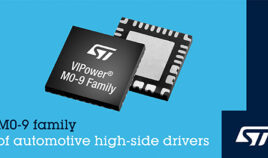As the name suggests, multimeters are those measuring instruments which can be used to calculate multiple circuit characteristics. Making them digital gives highly precise outputs as unlike their analog counterparts, there is no needle whose pointer is to be figured out. Multimeters are into electronic measurement purposes since long and are expected to stay for long and get more modifications of measuring quantities. Analog multimeters were initially in trend but required calibration and human error often caused errors in measurements. With digital measurements, results are not only more accurate but can also be resolved to a high level.
JLR vehicles to feature 5G, Wi-Fi, and C-V2X capabilities
Qualcomm Technologies and JLR announced that the companies will work together to bring 5G capabilities to select next-generation JLR vehicles across its brands Range Rover, Defender, Discovery, and Jaguar. As a part of JLR’s efforts in building a sustainability-rich vision of modern luxury by design, the ongoing technology collaboration between Qualcomm Technologies and JLR aims…
New single-chip, digital-power controller simplifies design in LED-lighting applications
STMicroelectronics’ STNRG012 is a highly integrated and space-saving digital power controller with advanced distortion mitigation that delivers an ideal solution for LED-lighting applications. The device contains a multimode power-factor correction (PFC) controller, resonant half-bridge controller, and 800V startup circuit that’s all managed by a digital engine. The PFC controller changes dynamically between transition mode, discontinuous-current mode (DCM),…
STMicroelectronics launches 2.5V digital-to-analog converter for satellite applications
STMicroelectronics‘ RHRDAC121 radiation-hardened, digital-to-analog converter (DAC) operates down to 2.5V for use in modern, low-power system designs that older 3.3V parts cannot support. Consuming just 0.6mW at its maximum speed and supply voltage, the 12-bit 1Msps successive approximation register (SAR) DAC helps reduce size, weight, and power (SWaP) in next-generation satellites. Typically used in circuits…
How to design a digital compass using Arduino and an HMC5883L magnetometer
Digital compasses are electronic devices that use sensors to determine the magnetic field, displaying the navigational direction numerically. These types of compasses typically use a magnetometer sensor to measure the strength of the magnetic field to detect the direction. One low-cost, three-axis digital magnetometer is the HMC5883L. It measures the value of the magnetic field…
How to program an OLED display with Arduino
Sensors are used to convert a physical quantity, such as light intensity or temperature, into an electrical one. There are several types of sensors that can easily be used with an Arduino board, which is an advantage. For example, any analog or digital sensor easily interfaces with Arduino as the board offers both analog and…
Renesas offers new pressure-sensing solution for automotive applications
Renesas Electronics Corporation, a supplier of advanced semiconductor solutions, is introducing the RAA2S425x Family of ICs for automotive pressure-sensing systems. The new devices provide highly accurate amplification and sensor-specific correction of signals in automotive xEV/EV/FCEV pressure sensing braking, transmission and HVAC systems. The RAA2S425x Product Family features high integration and advanced digital and analog functionality…
STMicroelectronics introduces new generation of automotive intelligent switches
The VN9D30Q100F and VN9D5D20FN from STMicroelectronics introduce a new generation of automotive intelligent switches — the first in the market with digital current sensing among the fully digital on-chip diagnostic features. Designed for high-side connection in applications powered from a 12V battery, the drivers simplify the hardware and software design of electronic control units (ECUs)…
Microchip launches fully configurable, digital gate driver for silicon-carbide MOSFETs
As demand for electric buses and other electrified heavy transport vehicles increases to meet lower emission targets, silicon carbide-based power management solutions are providing greater efficiencies in these transportation systems. To complement its broad portfolio of silicon carbide MOSFET discrete and module products, Microchip Technology has announced a new 1200V production-ready digital gate driver —…
STMicroelectronics offers eco-friendly digital-power solution for LED TVs
The STEVAL-NRG011TV board from STMicroelectronics helps designers quickly build 200W digital-power supplies and adapters for LED and OLED televisions to exceed the toughest energy-efficiency and standby regulations. Based on ST’s STNRG011 digital PFC (power-factor correction) and resonant LLC converter, the STEVAL-NRG011TV combines a proven and reliable topology with the ability to configure and fine-tune the operating parameters for optimal…
An Introduction to Analog Electronics
The world of electronics is all about electrical circuits, electronic components, and interconnected technologies. All these elements can be primarily categorized as digital, analog, or a combination of both. However, here we will be focusing on the basics of the analog category in detail. Analog electronics is a branch of electronics that deals with a continuously variable signal. It’s widely used in radio and audio equipment along with other applications where signals are derived from analog sensors before being converted into digital signals for subsequent storage and processing. Although digital circuits are considered as a dominant part of today’s technological world, some of the most fundamental components in a digital system are actually analog in nature.










